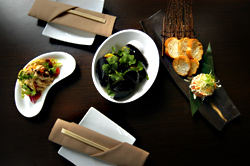What do you get when you stock a CD changer with Astor Piazzolla, traditional Japanese music, B-grade hip-hop, and Portishead, then press “random”? A prescient soundtrack, I discovered.
I spent a lot of time tracking the improbable playlist at Wann Japanese Izakaya, a two-month-old restaurant on Second Avenue and Lenora Street, because it so matched the shuffle of reactions Wann’s food evoked—delight, disappointment, awe, ridicule. The restaurant’s varied, far-beyond-sushi menu is definitely worth a try, but the randomness of the quality may keep you from coming back.
Beyond question, Wann is gorgeous, especially if you’re sitting at the back in one of the raised, slat-walled booths, with tiny halogens casting their sharp, blue-white arcs over the table. From there, you look out across the pattern of mahogany-brown tables with cream-colored chairs, up at the rustic beams that frame and reframe the room, out through a glass screen etched like the fabric of a century-old kimono. Diners not lucky enough to score a booth tend to stare curiously at those who have, because the booths appear to hover several feet over a lighted rock garden. The backlit grillwork over the bar, on the other side of the restaurant, is an equally impressive sight, as is the wall on the building next door, which is being spray-painted a Wann brandscape.
The traditional izakaya (the word comes from sakaya, a place where you drink sake) is not a fancy place. It’s sort of a perennial happy-hour spot for after-work drinkers, where beer, sake, and shochu (a distilled spirit) are the main draw and everything else is, well, bar snacks.
In recent times, the mom-and-pop izakayas patronized by salarymen have been supplemented by cleaner, flashier gastropubs for “young professional” types. New-generation izakayas like Wann are also appearing on the West Coast, satisfying Americans’ renewed infatuation with high-end Japanese cuisine and our longer-term desire for small-plates dining.
True to form, Wann offers several dozen small dishes, arranged by class—sashimi, salads, grilled items—and a few brands of sake, shochu, and beer (which you’re advised to stick to; though the bar is also stocked along American lines, house cocktails like a weak margarita with peppered-salt rim or a syrupy Seattle Rain, which a friend wincingly described as tasting like a Jelly Belly, were awful).
The room’s not the only beautiful aspect of the meal. Each food-porn-worthy dish comes on a plate seemingly designed for it. These range from speckled stoneware canoes to white ceramic squares, edges curled up as if they’d started to wither. Your order may come on a nest of pink translucent seaweed or have deep-fried egg noodles sticking out of it; one dessert even arrived under a sepia cloud of spun sugar.
Some of the food holds true to classic Japanese flavors: A small bowl of green beans was tossed with sesame paste and showered with pink, salty flakes of dried bonito tuna; the lovely, mom-food yaki onigiri (two dense rice balls browned on the grill) were speckled throughout with dried shrimp, the starchiness counteracted with puckery pickled vegetables. Biting into the luscious scallop sashimi—thick slices passed over a flame so they blackened just at the edges—was like tasting satin.
That’s not to say that the classic dishes were uniformly good—I’ve eaten less greasy, more skillfully battered tempura at my local teriyaki joint—or that traditional Japanese flavors will appeal to outsiders. The braised mountain potato, for example, had a texture somewhere between crisp jicama slices and slimy cooked okra. We were expecting a little adventure when we ordered chinmi, defined on the menu as a “selection of Japanese delicacies,” and the three condiment bowls presented to us were certainly a dare: crunchy octopus pickled in wasabi, raw baby squid, and Korean-style fish intestines. The strong-flavored snacks were supposed to stimulate drinking, explained our waiter; they had me downing sake to bolster my confidence.
To his credit, our waiter never tried to dissuade a table of white folks from ordering the chinmi. In fact, the service as a whole was smooth and professional; servers good-naturedly translated any foreign terms and even scoured the restaurant to find a free propane burner so we could taste one night’s hearty, simple chicken and pork hot pot, which had proved more popular than the kitchen had expected.
The homey soup gave us a respite from the more creative East-studies-West dishes, which certainly deserved credit for their ambition, if you catch my drift. There was the “veggie gateau,” for instance, a huge vegetarian sushi roll whose flavor was muffled by lots of lettuce and gloopy tofu-miso purée. Duck harihari salad was crowned with beautifully rare duck meat, but the mizuna salad underneath was tossed in a brothy soy dressing that proved too wimpy for the duck. And the chicken nanban—marinated thigh meat coated in a thick batter and deep-fried, but not quite long enough—was presented with tartar sauce ladled over the top as if it were Cool Whip on an apple pie. Gross.
But sometimes we enjoyed the experimentation: “Tuna tomato” was a bizarre- looking but tasty ball of rice covered in petals of ahi tuna so that it looked like a ripe fruit. Kurobuta sausage, made with premium-quality “black pig” meat, tasted like a particularly juicy Oscar Mayer wiener. The custard in a crème brûlée was a touch loose, but had a lovely bourbon-caramel flavor that came from kokutou, an Okinawan unrefined sugar.
My meals at Wann presented a gastronomic spectacle quite worth experiencing. But after two meals, I still can’t recommend whether you should stick to the sashimi or classic grilled meats, say, or steer toward the East-West stuff—there’s no logic as to what succeeds and what doesn’t. While I love to take risks as much as the next guy, a compulsive gambler I am not.






